Audit Risk and Procedures for Always Precise Instruments Pty Limited
VerifiedAdded on 2023/01/11
|16
|3840
|46
AI Summary
This memo discusses the identification of potential audit risks for Always Precise Instruments Pty Limited and suggests audit procedures to reduce those risks. The risks include stock out or overstock, incorrect recording of raw material receipts, and lack of emergency inventory options. The suggested procedures involve regular stock inspection, manual receipt counting, and installation of emergency inventory options.
Contribute Materials
Your contribution can guide someone’s learning journey. Share your
documents today.
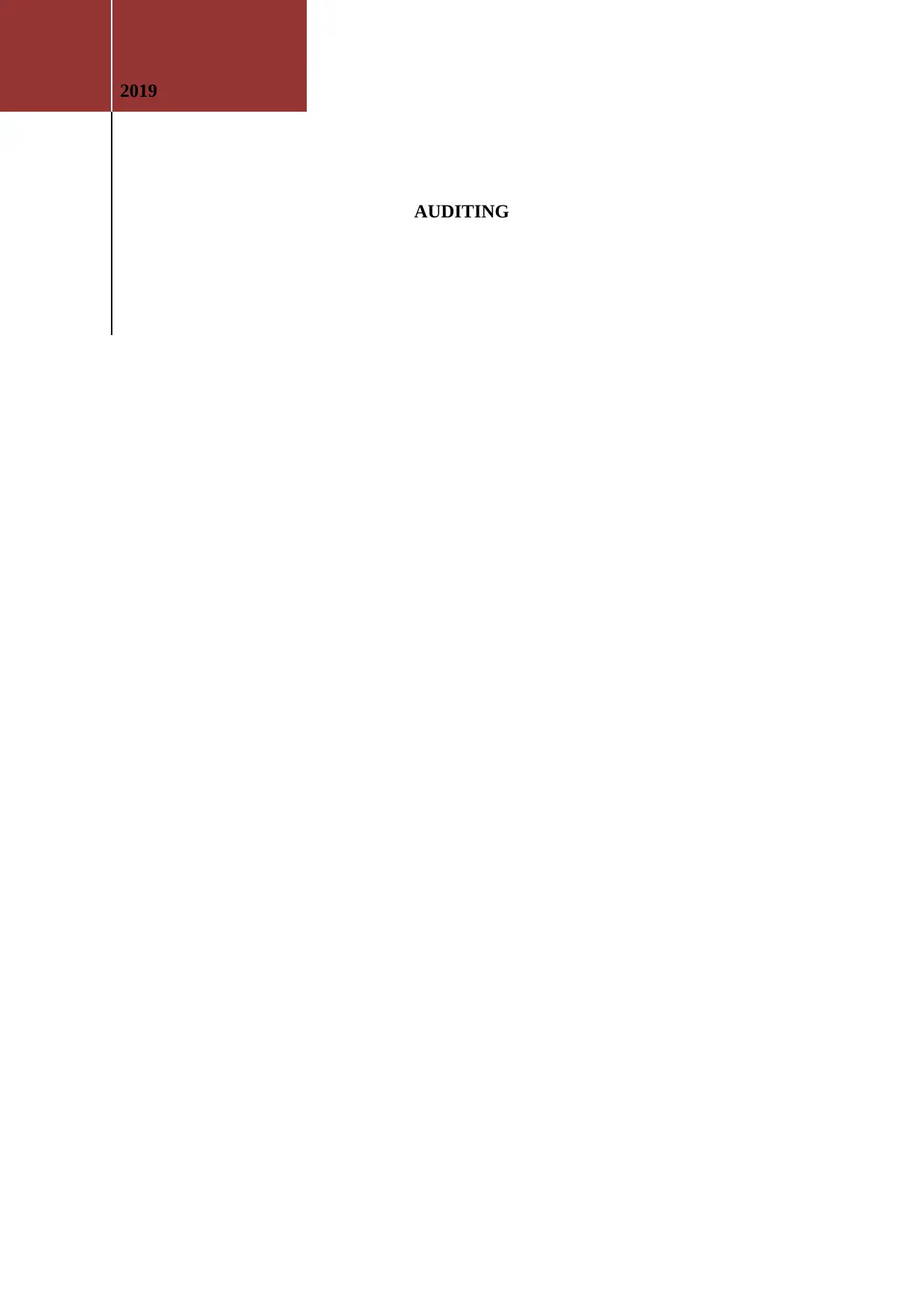
AUDITING
2019
2019
Secure Best Marks with AI Grader
Need help grading? Try our AI Grader for instant feedback on your assignments.
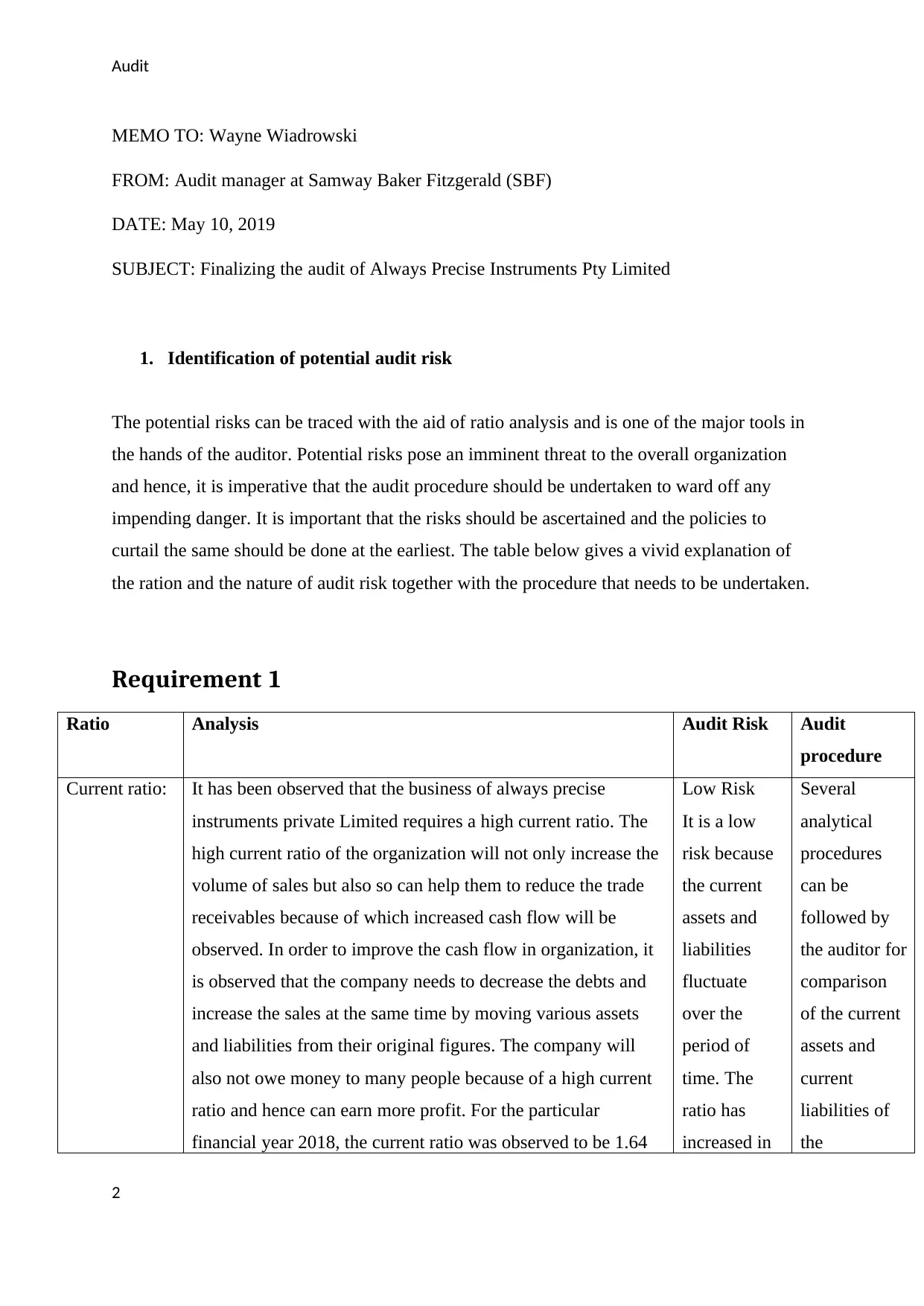
Audit
MEMO TO: Wayne Wiadrowski
FROM: Audit manager at Samway Baker Fitzgerald (SBF)
DATE: May 10, 2019
SUBJECT: Finalizing the audit of Always Precise Instruments Pty Limited
1. Identification of potential audit risk
The potential risks can be traced with the aid of ratio analysis and is one of the major tools in
the hands of the auditor. Potential risks pose an imminent threat to the overall organization
and hence, it is imperative that the audit procedure should be undertaken to ward off any
impending danger. It is important that the risks should be ascertained and the policies to
curtail the same should be done at the earliest. The table below gives a vivid explanation of
the ration and the nature of audit risk together with the procedure that needs to be undertaken.
Requirement 1
Ratio Analysis Audit Risk Audit
procedure
Current ratio: It has been observed that the business of always precise
instruments private Limited requires a high current ratio. The
high current ratio of the organization will not only increase the
volume of sales but also so can help them to reduce the trade
receivables because of which increased cash flow will be
observed. In order to improve the cash flow in organization, it
is observed that the company needs to decrease the debts and
increase the sales at the same time by moving various assets
and liabilities from their original figures. The company will
also not owe money to many people because of a high current
ratio and hence can earn more profit. For the particular
financial year 2018, the current ratio was observed to be 1.64
Low Risk
It is a low
risk because
the current
assets and
liabilities
fluctuate
over the
period of
time. The
ratio has
increased in
Several
analytical
procedures
can be
followed by
the auditor for
comparison
of the current
assets and
current
liabilities of
the
2
MEMO TO: Wayne Wiadrowski
FROM: Audit manager at Samway Baker Fitzgerald (SBF)
DATE: May 10, 2019
SUBJECT: Finalizing the audit of Always Precise Instruments Pty Limited
1. Identification of potential audit risk
The potential risks can be traced with the aid of ratio analysis and is one of the major tools in
the hands of the auditor. Potential risks pose an imminent threat to the overall organization
and hence, it is imperative that the audit procedure should be undertaken to ward off any
impending danger. It is important that the risks should be ascertained and the policies to
curtail the same should be done at the earliest. The table below gives a vivid explanation of
the ration and the nature of audit risk together with the procedure that needs to be undertaken.
Requirement 1
Ratio Analysis Audit Risk Audit
procedure
Current ratio: It has been observed that the business of always precise
instruments private Limited requires a high current ratio. The
high current ratio of the organization will not only increase the
volume of sales but also so can help them to reduce the trade
receivables because of which increased cash flow will be
observed. In order to improve the cash flow in organization, it
is observed that the company needs to decrease the debts and
increase the sales at the same time by moving various assets
and liabilities from their original figures. The company will
also not owe money to many people because of a high current
ratio and hence can earn more profit. For the particular
financial year 2018, the current ratio was observed to be 1.64
Low Risk
It is a low
risk because
the current
assets and
liabilities
fluctuate
over the
period of
time. The
ratio has
increased in
Several
analytical
procedures
can be
followed by
the auditor for
comparison
of the current
assets and
current
liabilities of
the
2
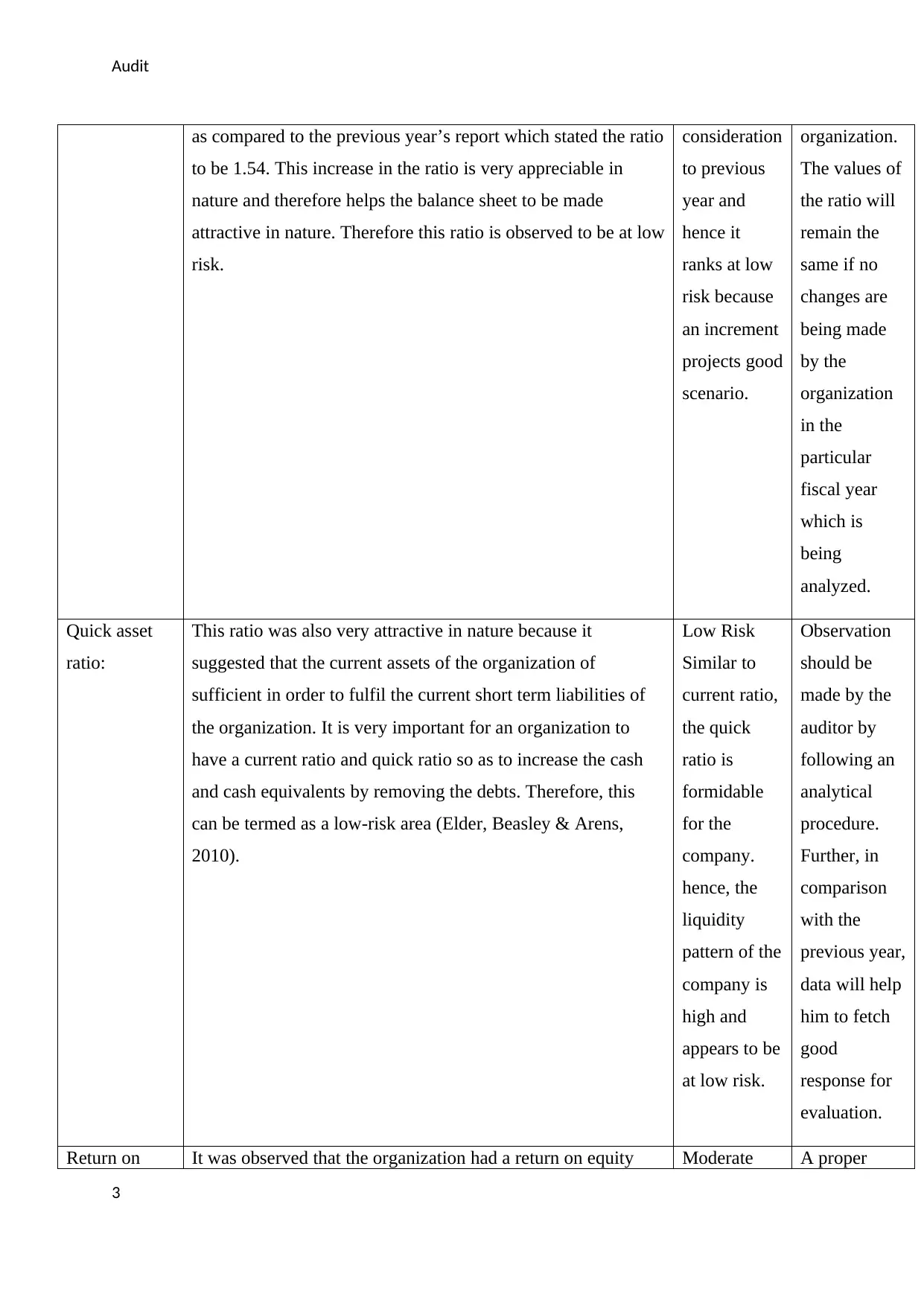
Audit
as compared to the previous year’s report which stated the ratio
to be 1.54. This increase in the ratio is very appreciable in
nature and therefore helps the balance sheet to be made
attractive in nature. Therefore this ratio is observed to be at low
risk.
consideration
to previous
year and
hence it
ranks at low
risk because
an increment
projects good
scenario.
organization.
The values of
the ratio will
remain the
same if no
changes are
being made
by the
organization
in the
particular
fiscal year
which is
being
analyzed.
Quick asset
ratio:
This ratio was also very attractive in nature because it
suggested that the current assets of the organization of
sufficient in order to fulfil the current short term liabilities of
the organization. It is very important for an organization to
have a current ratio and quick ratio so as to increase the cash
and cash equivalents by removing the debts. Therefore, this
can be termed as a low-risk area (Elder, Beasley & Arens,
2010).
Low Risk
Similar to
current ratio,
the quick
ratio is
formidable
for the
company.
hence, the
liquidity
pattern of the
company is
high and
appears to be
at low risk.
Observation
should be
made by the
auditor by
following an
analytical
procedure.
Further, in
comparison
with the
previous year,
data will help
him to fetch
good
response for
evaluation.
Return on It was observed that the organization had a return on equity Moderate A proper
3
as compared to the previous year’s report which stated the ratio
to be 1.54. This increase in the ratio is very appreciable in
nature and therefore helps the balance sheet to be made
attractive in nature. Therefore this ratio is observed to be at low
risk.
consideration
to previous
year and
hence it
ranks at low
risk because
an increment
projects good
scenario.
organization.
The values of
the ratio will
remain the
same if no
changes are
being made
by the
organization
in the
particular
fiscal year
which is
being
analyzed.
Quick asset
ratio:
This ratio was also very attractive in nature because it
suggested that the current assets of the organization of
sufficient in order to fulfil the current short term liabilities of
the organization. It is very important for an organization to
have a current ratio and quick ratio so as to increase the cash
and cash equivalents by removing the debts. Therefore, this
can be termed as a low-risk area (Elder, Beasley & Arens,
2010).
Low Risk
Similar to
current ratio,
the quick
ratio is
formidable
for the
company.
hence, the
liquidity
pattern of the
company is
high and
appears to be
at low risk.
Observation
should be
made by the
auditor by
following an
analytical
procedure.
Further, in
comparison
with the
previous year,
data will help
him to fetch
good
response for
evaluation.
Return on It was observed that the organization had a return on equity Moderate A proper
3
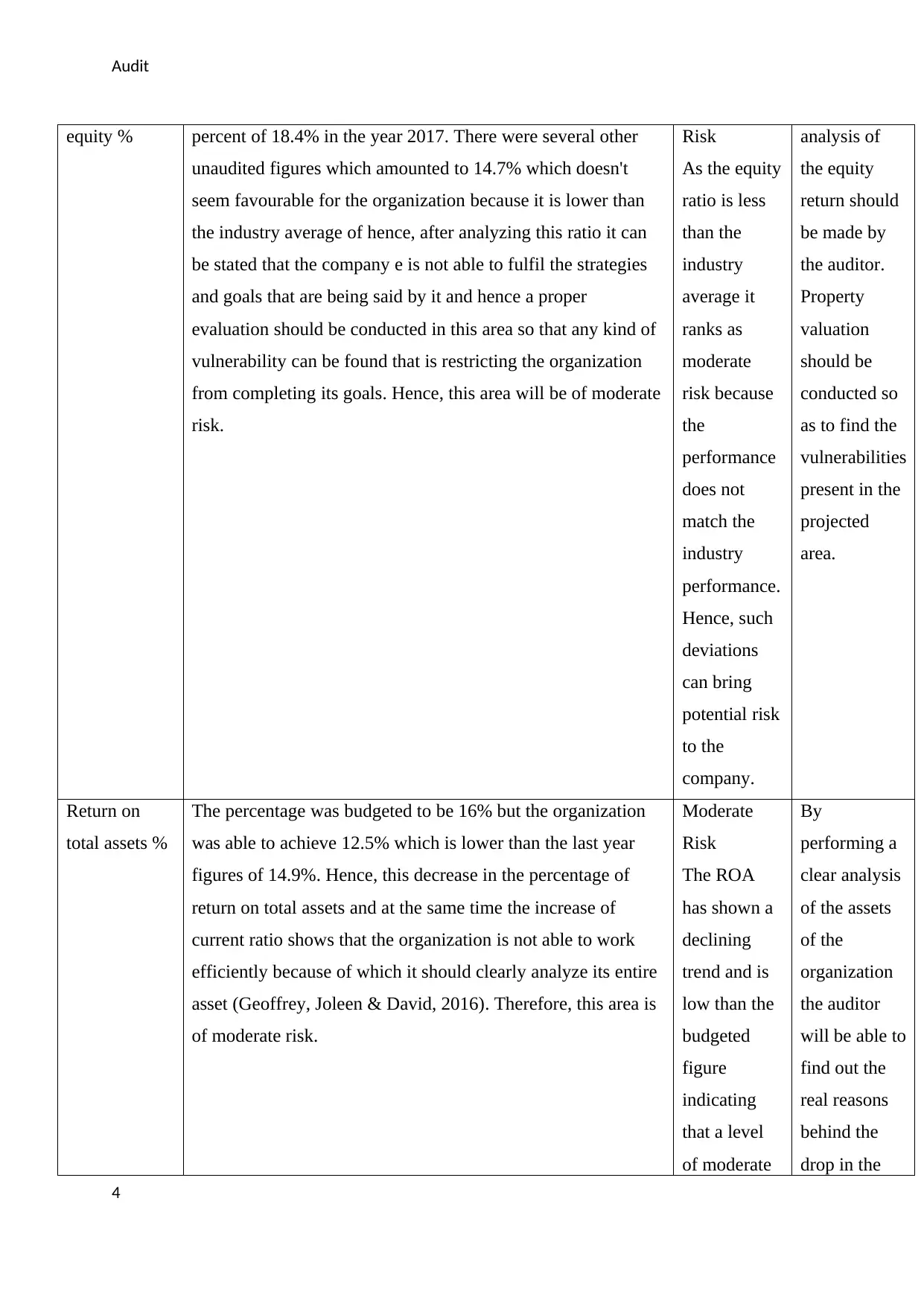
Audit
equity % percent of 18.4% in the year 2017. There were several other
unaudited figures which amounted to 14.7% which doesn't
seem favourable for the organization because it is lower than
the industry average of hence, after analyzing this ratio it can
be stated that the company e is not able to fulfil the strategies
and goals that are being said by it and hence a proper
evaluation should be conducted in this area so that any kind of
vulnerability can be found that is restricting the organization
from completing its goals. Hence, this area will be of moderate
risk.
Risk
As the equity
ratio is less
than the
industry
average it
ranks as
moderate
risk because
the
performance
does not
match the
industry
performance.
Hence, such
deviations
can bring
potential risk
to the
company.
analysis of
the equity
return should
be made by
the auditor.
Property
valuation
should be
conducted so
as to find the
vulnerabilities
present in the
projected
area.
Return on
total assets %
The percentage was budgeted to be 16% but the organization
was able to achieve 12.5% which is lower than the last year
figures of 14.9%. Hence, this decrease in the percentage of
return on total assets and at the same time the increase of
current ratio shows that the organization is not able to work
efficiently because of which it should clearly analyze its entire
asset (Geoffrey, Joleen & David, 2016). Therefore, this area is
of moderate risk.
Moderate
Risk
The ROA
has shown a
declining
trend and is
low than the
budgeted
figure
indicating
that a level
of moderate
By
performing a
clear analysis
of the assets
of the
organization
the auditor
will be able to
find out the
real reasons
behind the
drop in the
4
equity % percent of 18.4% in the year 2017. There were several other
unaudited figures which amounted to 14.7% which doesn't
seem favourable for the organization because it is lower than
the industry average of hence, after analyzing this ratio it can
be stated that the company e is not able to fulfil the strategies
and goals that are being said by it and hence a proper
evaluation should be conducted in this area so that any kind of
vulnerability can be found that is restricting the organization
from completing its goals. Hence, this area will be of moderate
risk.
Risk
As the equity
ratio is less
than the
industry
average it
ranks as
moderate
risk because
the
performance
does not
match the
industry
performance.
Hence, such
deviations
can bring
potential risk
to the
company.
analysis of
the equity
return should
be made by
the auditor.
Property
valuation
should be
conducted so
as to find the
vulnerabilities
present in the
projected
area.
Return on
total assets %
The percentage was budgeted to be 16% but the organization
was able to achieve 12.5% which is lower than the last year
figures of 14.9%. Hence, this decrease in the percentage of
return on total assets and at the same time the increase of
current ratio shows that the organization is not able to work
efficiently because of which it should clearly analyze its entire
asset (Geoffrey, Joleen & David, 2016). Therefore, this area is
of moderate risk.
Moderate
Risk
The ROA
has shown a
declining
trend and is
low than the
budgeted
figure
indicating
that a level
of moderate
By
performing a
clear analysis
of the assets
of the
organization
the auditor
will be able to
find out the
real reasons
behind the
drop in the
4
Secure Best Marks with AI Grader
Need help grading? Try our AI Grader for instant feedback on your assignments.
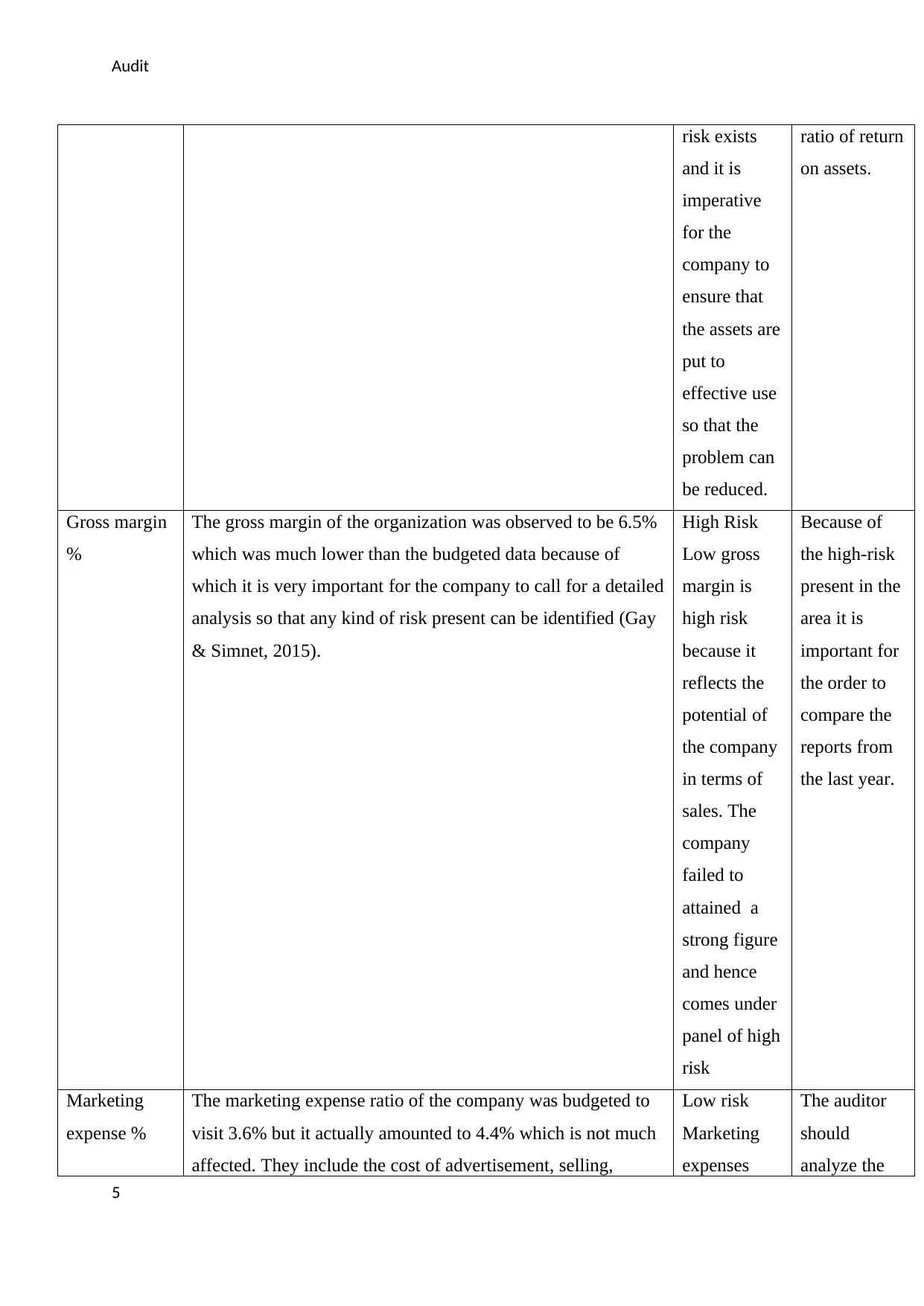
Audit
risk exists
and it is
imperative
for the
company to
ensure that
the assets are
put to
effective use
so that the
problem can
be reduced.
ratio of return
on assets.
Gross margin
%
The gross margin of the organization was observed to be 6.5%
which was much lower than the budgeted data because of
which it is very important for the company to call for a detailed
analysis so that any kind of risk present can be identified (Gay
& Simnet, 2015).
High Risk
Low gross
margin is
high risk
because it
reflects the
potential of
the company
in terms of
sales. The
company
failed to
attained a
strong figure
and hence
comes under
panel of high
risk
Because of
the high-risk
present in the
area it is
important for
the order to
compare the
reports from
the last year.
Marketing
expense %
The marketing expense ratio of the company was budgeted to
visit 3.6% but it actually amounted to 4.4% which is not much
affected. They include the cost of advertisement, selling,
Low risk
Marketing
expenses
The auditor
should
analyze the
5
risk exists
and it is
imperative
for the
company to
ensure that
the assets are
put to
effective use
so that the
problem can
be reduced.
ratio of return
on assets.
Gross margin
%
The gross margin of the organization was observed to be 6.5%
which was much lower than the budgeted data because of
which it is very important for the company to call for a detailed
analysis so that any kind of risk present can be identified (Gay
& Simnet, 2015).
High Risk
Low gross
margin is
high risk
because it
reflects the
potential of
the company
in terms of
sales. The
company
failed to
attained a
strong figure
and hence
comes under
panel of high
risk
Because of
the high-risk
present in the
area it is
important for
the order to
compare the
reports from
the last year.
Marketing
expense %
The marketing expense ratio of the company was budgeted to
visit 3.6% but it actually amounted to 4.4% which is not much
affected. They include the cost of advertisement, selling,
Low risk
Marketing
expenses
The auditor
should
analyze the
5
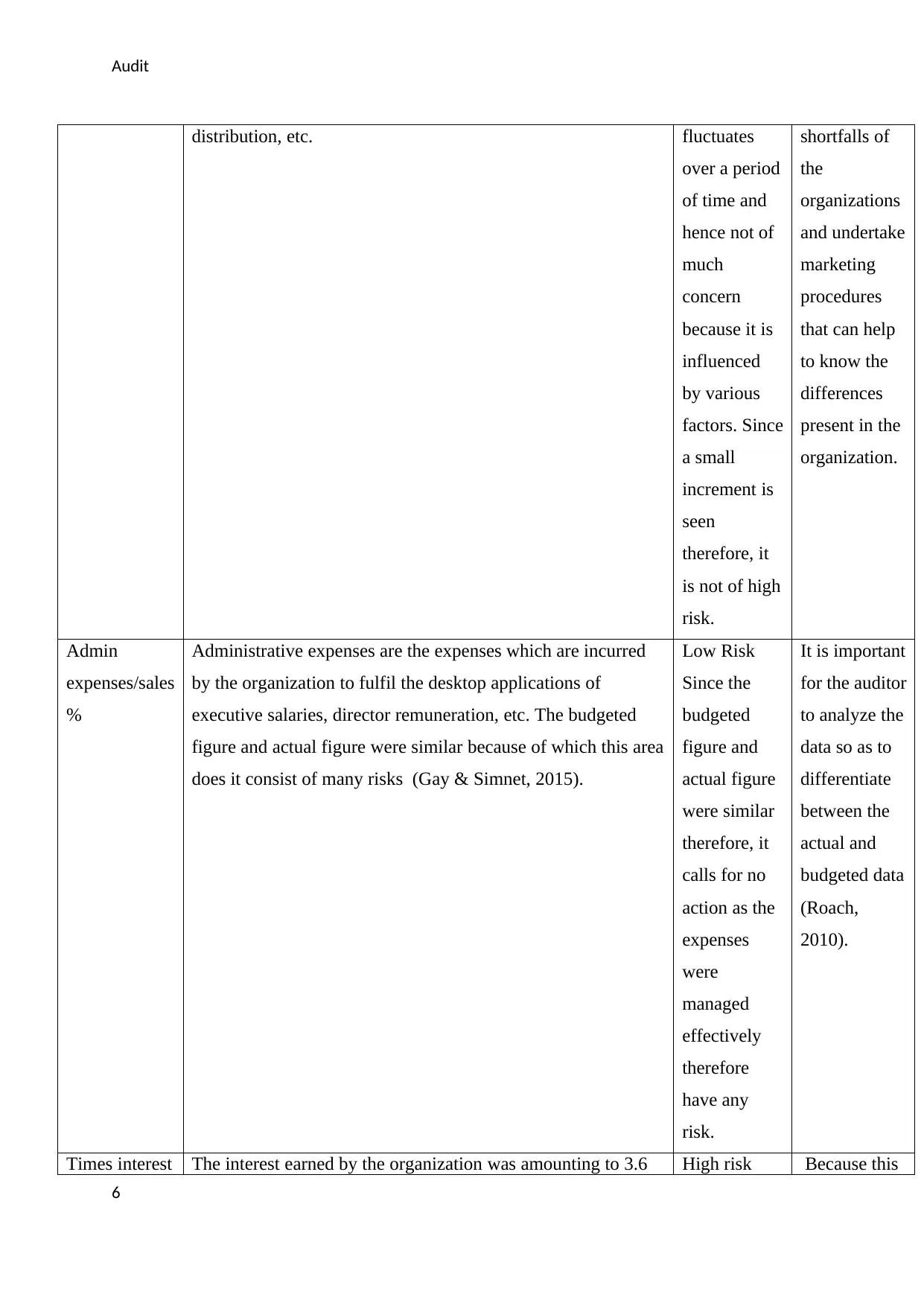
Audit
distribution, etc. fluctuates
over a period
of time and
hence not of
much
concern
because it is
influenced
by various
factors. Since
a small
increment is
seen
therefore, it
is not of high
risk.
shortfalls of
the
organizations
and undertake
marketing
procedures
that can help
to know the
differences
present in the
organization.
Admin
expenses/sales
%
Administrative expenses are the expenses which are incurred
by the organization to fulfil the desktop applications of
executive salaries, director remuneration, etc. The budgeted
figure and actual figure were similar because of which this area
does it consist of many risks (Gay & Simnet, 2015).
Low Risk
Since the
budgeted
figure and
actual figure
were similar
therefore, it
calls for no
action as the
expenses
were
managed
effectively
therefore
have any
risk.
It is important
for the auditor
to analyze the
data so as to
differentiate
between the
actual and
budgeted data
(Roach,
2010).
Times interest The interest earned by the organization was amounting to 3.6 High risk Because this
6
distribution, etc. fluctuates
over a period
of time and
hence not of
much
concern
because it is
influenced
by various
factors. Since
a small
increment is
seen
therefore, it
is not of high
risk.
shortfalls of
the
organizations
and undertake
marketing
procedures
that can help
to know the
differences
present in the
organization.
Admin
expenses/sales
%
Administrative expenses are the expenses which are incurred
by the organization to fulfil the desktop applications of
executive salaries, director remuneration, etc. The budgeted
figure and actual figure were similar because of which this area
does it consist of many risks (Gay & Simnet, 2015).
Low Risk
Since the
budgeted
figure and
actual figure
were similar
therefore, it
calls for no
action as the
expenses
were
managed
effectively
therefore
have any
risk.
It is important
for the auditor
to analyze the
data so as to
differentiate
between the
actual and
budgeted data
(Roach,
2010).
Times interest The interest earned by the organization was amounting to 3.6 High risk Because this
6
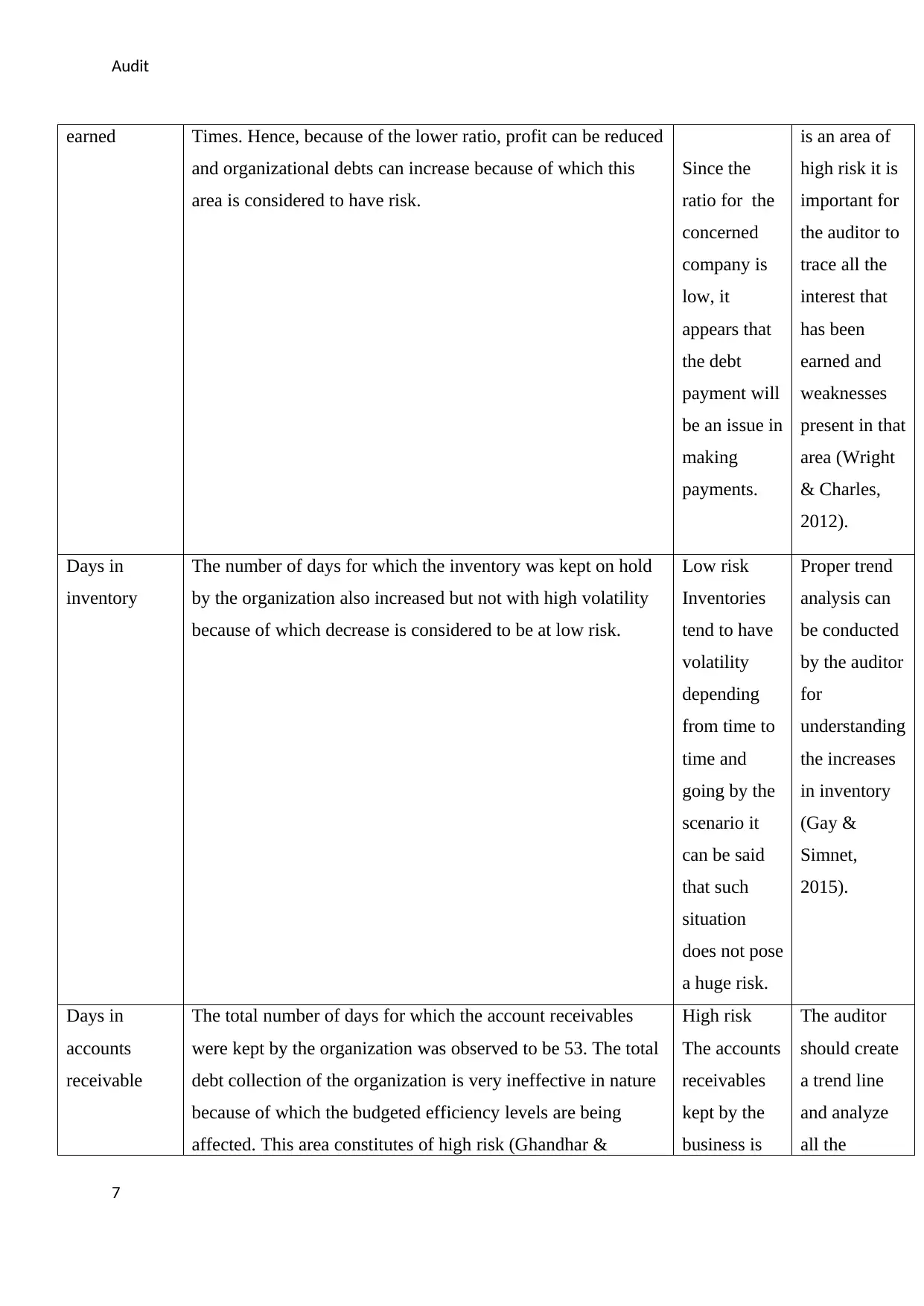
Audit
earned Times. Hence, because of the lower ratio, profit can be reduced
and organizational debts can increase because of which this
area is considered to have risk.
Since the
ratio for the
concerned
company is
low, it
appears that
the debt
payment will
be an issue in
making
payments.
is an area of
high risk it is
important for
the auditor to
trace all the
interest that
has been
earned and
weaknesses
present in that
area (Wright
& Charles,
2012).
Days in
inventory
The number of days for which the inventory was kept on hold
by the organization also increased but not with high volatility
because of which decrease is considered to be at low risk.
Low risk
Inventories
tend to have
volatility
depending
from time to
time and
going by the
scenario it
can be said
that such
situation
does not pose
a huge risk.
Proper trend
analysis can
be conducted
by the auditor
for
understanding
the increases
in inventory
(Gay &
Simnet,
2015).
Days in
accounts
receivable
The total number of days for which the account receivables
were kept by the organization was observed to be 53. The total
debt collection of the organization is very ineffective in nature
because of which the budgeted efficiency levels are being
affected. This area constitutes of high risk (Ghandhar &
High risk
The accounts
receivables
kept by the
business is
The auditor
should create
a trend line
and analyze
all the
7
earned Times. Hence, because of the lower ratio, profit can be reduced
and organizational debts can increase because of which this
area is considered to have risk.
Since the
ratio for the
concerned
company is
low, it
appears that
the debt
payment will
be an issue in
making
payments.
is an area of
high risk it is
important for
the auditor to
trace all the
interest that
has been
earned and
weaknesses
present in that
area (Wright
& Charles,
2012).
Days in
inventory
The number of days for which the inventory was kept on hold
by the organization also increased but not with high volatility
because of which decrease is considered to be at low risk.
Low risk
Inventories
tend to have
volatility
depending
from time to
time and
going by the
scenario it
can be said
that such
situation
does not pose
a huge risk.
Proper trend
analysis can
be conducted
by the auditor
for
understanding
the increases
in inventory
(Gay &
Simnet,
2015).
Days in
accounts
receivable
The total number of days for which the account receivables
were kept by the organization was observed to be 53. The total
debt collection of the organization is very ineffective in nature
because of which the budgeted efficiency levels are being
affected. This area constitutes of high risk (Ghandhar &
High risk
The accounts
receivables
kept by the
business is
The auditor
should create
a trend line
and analyze
all the
7
Paraphrase This Document
Need a fresh take? Get an instant paraphrase of this document with our AI Paraphraser
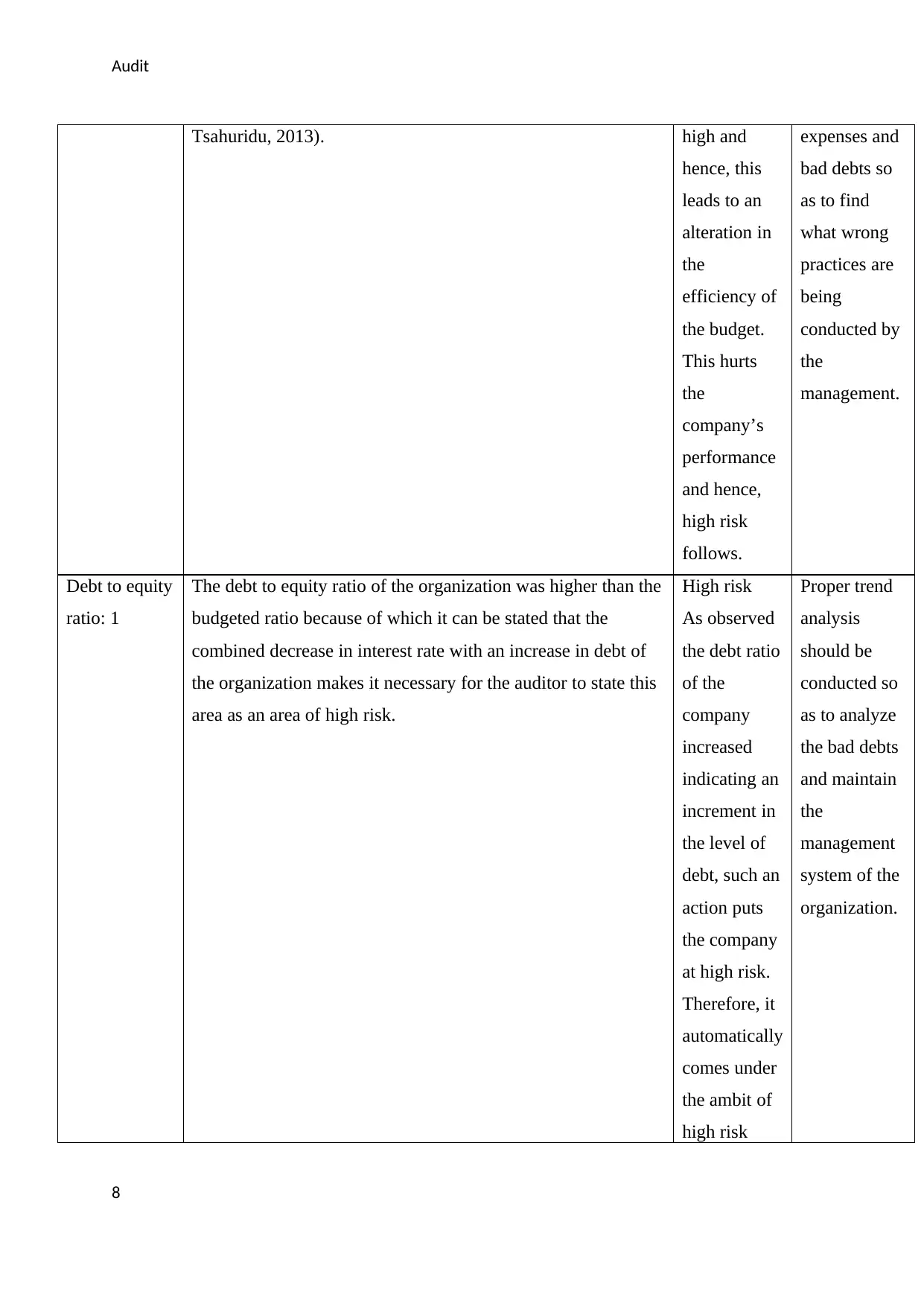
Audit
Tsahuridu, 2013). high and
hence, this
leads to an
alteration in
the
efficiency of
the budget.
This hurts
the
company’s
performance
and hence,
high risk
follows.
expenses and
bad debts so
as to find
what wrong
practices are
being
conducted by
the
management.
Debt to equity
ratio: 1
The debt to equity ratio of the organization was higher than the
budgeted ratio because of which it can be stated that the
combined decrease in interest rate with an increase in debt of
the organization makes it necessary for the auditor to state this
area as an area of high risk.
High risk
As observed
the debt ratio
of the
company
increased
indicating an
increment in
the level of
debt, such an
action puts
the company
at high risk.
Therefore, it
automatically
comes under
the ambit of
high risk
Proper trend
analysis
should be
conducted so
as to analyze
the bad debts
and maintain
the
management
system of the
organization.
8
Tsahuridu, 2013). high and
hence, this
leads to an
alteration in
the
efficiency of
the budget.
This hurts
the
company’s
performance
and hence,
high risk
follows.
expenses and
bad debts so
as to find
what wrong
practices are
being
conducted by
the
management.
Debt to equity
ratio: 1
The debt to equity ratio of the organization was higher than the
budgeted ratio because of which it can be stated that the
combined decrease in interest rate with an increase in debt of
the organization makes it necessary for the auditor to state this
area as an area of high risk.
High risk
As observed
the debt ratio
of the
company
increased
indicating an
increment in
the level of
debt, such an
action puts
the company
at high risk.
Therefore, it
automatically
comes under
the ambit of
high risk
Proper trend
analysis
should be
conducted so
as to analyze
the bad debts
and maintain
the
management
system of the
organization.
8
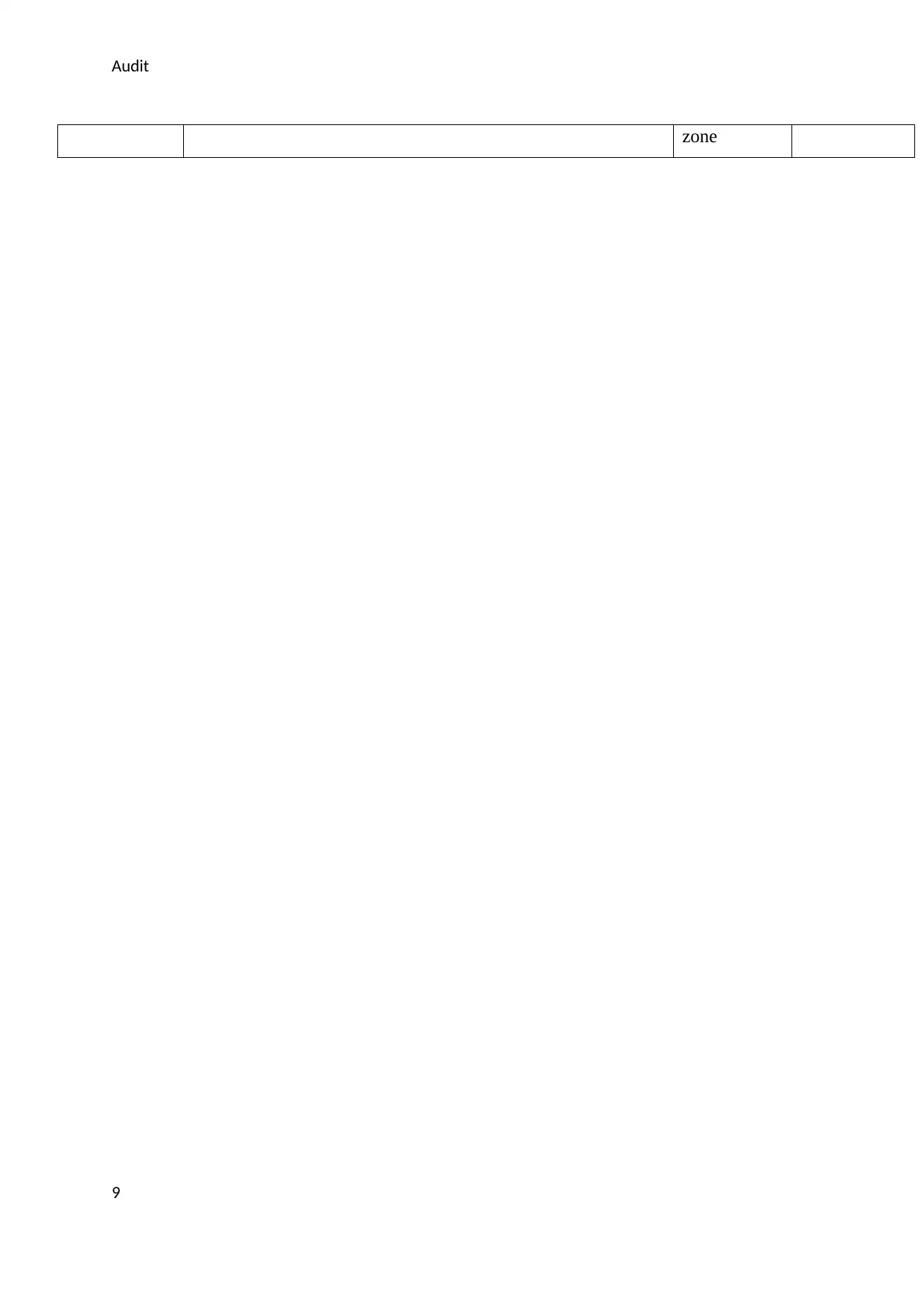
Audit
zone
9
zone
9
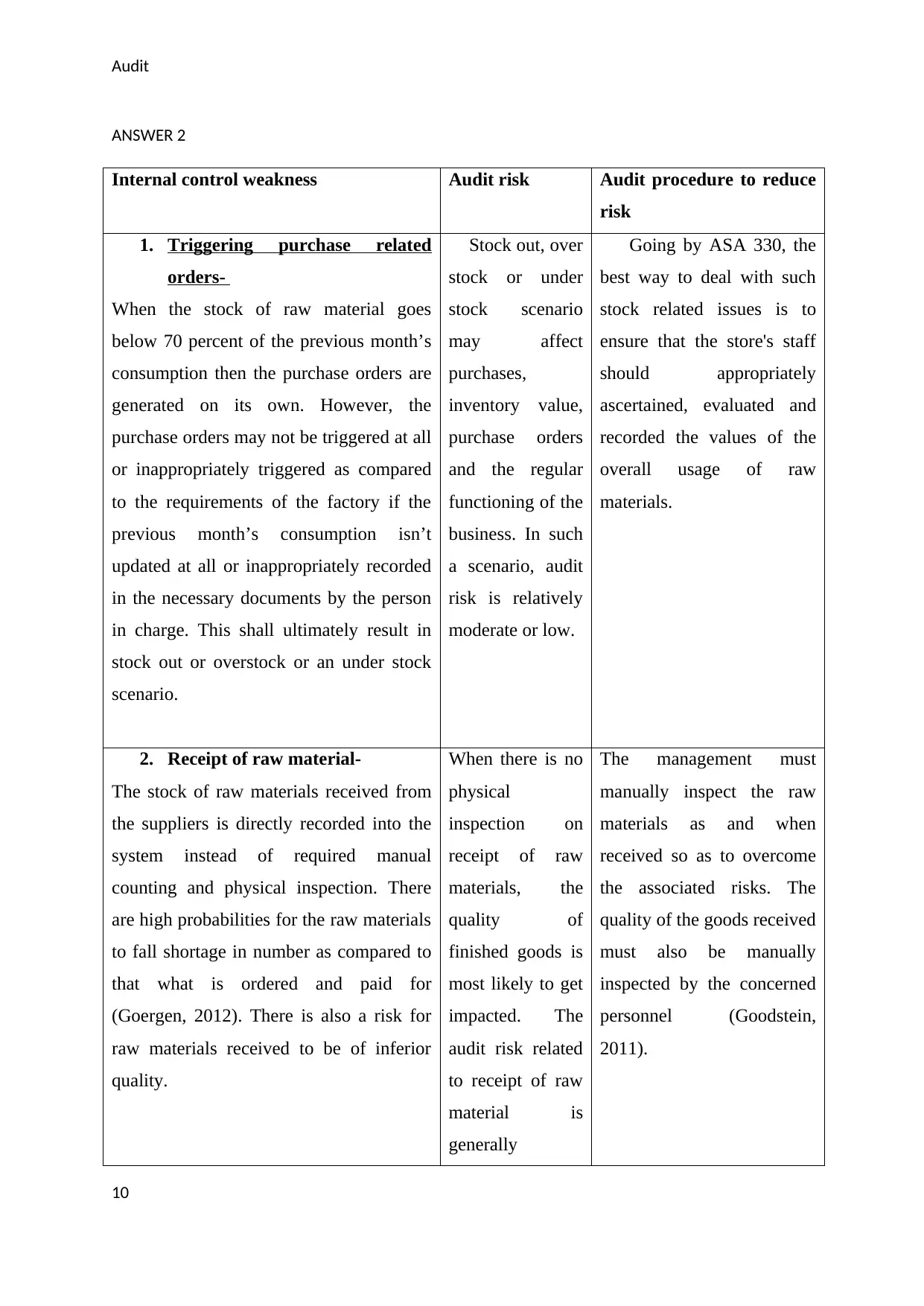
Audit
ANSWER 2
Internal control weakness Audit risk Audit procedure to reduce
risk
1. Triggering purchase related
orders-
When the stock of raw material goes
below 70 percent of the previous month’s
consumption then the purchase orders are
generated on its own. However, the
purchase orders may not be triggered at all
or inappropriately triggered as compared
to the requirements of the factory if the
previous month’s consumption isn’t
updated at all or inappropriately recorded
in the necessary documents by the person
in charge. This shall ultimately result in
stock out or overstock or an under stock
scenario.
Stock out, over
stock or under
stock scenario
may affect
purchases,
inventory value,
purchase orders
and the regular
functioning of the
business. In such
a scenario, audit
risk is relatively
moderate or low.
Going by ASA 330, the
best way to deal with such
stock related issues is to
ensure that the store's staff
should appropriately
ascertained, evaluated and
recorded the values of the
overall usage of raw
materials.
2. Receipt of raw material-
The stock of raw materials received from
the suppliers is directly recorded into the
system instead of required manual
counting and physical inspection. There
are high probabilities for the raw materials
to fall shortage in number as compared to
that what is ordered and paid for
(Goergen, 2012). There is also a risk for
raw materials received to be of inferior
quality.
When there is no
physical
inspection on
receipt of raw
materials, the
quality of
finished goods is
most likely to get
impacted. The
audit risk related
to receipt of raw
material is
generally
The management must
manually inspect the raw
materials as and when
received so as to overcome
the associated risks. The
quality of the goods received
must also be manually
inspected by the concerned
personnel (Goodstein,
2011).
10
ANSWER 2
Internal control weakness Audit risk Audit procedure to reduce
risk
1. Triggering purchase related
orders-
When the stock of raw material goes
below 70 percent of the previous month’s
consumption then the purchase orders are
generated on its own. However, the
purchase orders may not be triggered at all
or inappropriately triggered as compared
to the requirements of the factory if the
previous month’s consumption isn’t
updated at all or inappropriately recorded
in the necessary documents by the person
in charge. This shall ultimately result in
stock out or overstock or an under stock
scenario.
Stock out, over
stock or under
stock scenario
may affect
purchases,
inventory value,
purchase orders
and the regular
functioning of the
business. In such
a scenario, audit
risk is relatively
moderate or low.
Going by ASA 330, the
best way to deal with such
stock related issues is to
ensure that the store's staff
should appropriately
ascertained, evaluated and
recorded the values of the
overall usage of raw
materials.
2. Receipt of raw material-
The stock of raw materials received from
the suppliers is directly recorded into the
system instead of required manual
counting and physical inspection. There
are high probabilities for the raw materials
to fall shortage in number as compared to
that what is ordered and paid for
(Goergen, 2012). There is also a risk for
raw materials received to be of inferior
quality.
When there is no
physical
inspection on
receipt of raw
materials, the
quality of
finished goods is
most likely to get
impacted. The
audit risk related
to receipt of raw
material is
generally
The management must
manually inspect the raw
materials as and when
received so as to overcome
the associated risks. The
quality of the goods received
must also be manually
inspected by the concerned
personnel (Goodstein,
2011).
10
Secure Best Marks with AI Grader
Need help grading? Try our AI Grader for instant feedback on your assignments.
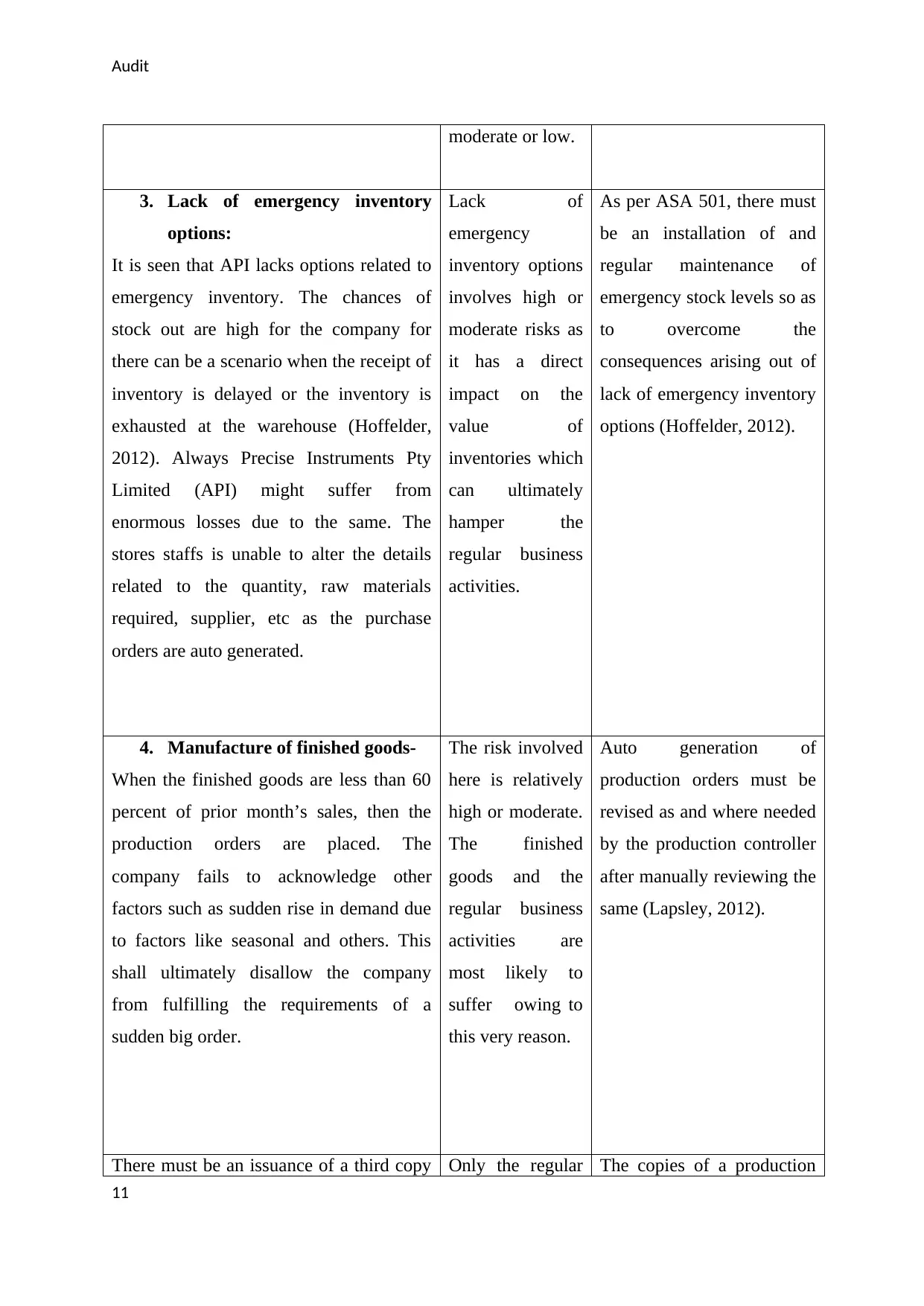
Audit
moderate or low.
3. Lack of emergency inventory
options:
It is seen that API lacks options related to
emergency inventory. The chances of
stock out are high for the company for
there can be a scenario when the receipt of
inventory is delayed or the inventory is
exhausted at the warehouse (Hoffelder,
2012). Always Precise Instruments Pty
Limited (API) might suffer from
enormous losses due to the same. The
stores staffs is unable to alter the details
related to the quantity, raw materials
required, supplier, etc as the purchase
orders are auto generated.
Lack of
emergency
inventory options
involves high or
moderate risks as
it has a direct
impact on the
value of
inventories which
can ultimately
hamper the
regular business
activities.
As per ASA 501, there must
be an installation of and
regular maintenance of
emergency stock levels so as
to overcome the
consequences arising out of
lack of emergency inventory
options (Hoffelder, 2012).
4. Manufacture of finished goods-
When the finished goods are less than 60
percent of prior month’s sales, then the
production orders are placed. The
company fails to acknowledge other
factors such as sudden rise in demand due
to factors like seasonal and others. This
shall ultimately disallow the company
from fulfilling the requirements of a
sudden big order.
The risk involved
here is relatively
high or moderate.
The finished
goods and the
regular business
activities are
most likely to
suffer owing to
this very reason.
Auto generation of
production orders must be
revised as and where needed
by the production controller
after manually reviewing the
same (Lapsley, 2012).
There must be an issuance of a third copy Only the regular The copies of a production
11
moderate or low.
3. Lack of emergency inventory
options:
It is seen that API lacks options related to
emergency inventory. The chances of
stock out are high for the company for
there can be a scenario when the receipt of
inventory is delayed or the inventory is
exhausted at the warehouse (Hoffelder,
2012). Always Precise Instruments Pty
Limited (API) might suffer from
enormous losses due to the same. The
stores staffs is unable to alter the details
related to the quantity, raw materials
required, supplier, etc as the purchase
orders are auto generated.
Lack of
emergency
inventory options
involves high or
moderate risks as
it has a direct
impact on the
value of
inventories which
can ultimately
hamper the
regular business
activities.
As per ASA 501, there must
be an installation of and
regular maintenance of
emergency stock levels so as
to overcome the
consequences arising out of
lack of emergency inventory
options (Hoffelder, 2012).
4. Manufacture of finished goods-
When the finished goods are less than 60
percent of prior month’s sales, then the
production orders are placed. The
company fails to acknowledge other
factors such as sudden rise in demand due
to factors like seasonal and others. This
shall ultimately disallow the company
from fulfilling the requirements of a
sudden big order.
The risk involved
here is relatively
high or moderate.
The finished
goods and the
regular business
activities are
most likely to
suffer owing to
this very reason.
Auto generation of
production orders must be
revised as and where needed
by the production controller
after manually reviewing the
same (Lapsley, 2012).
There must be an issuance of a third copy Only the regular The copies of a production
11
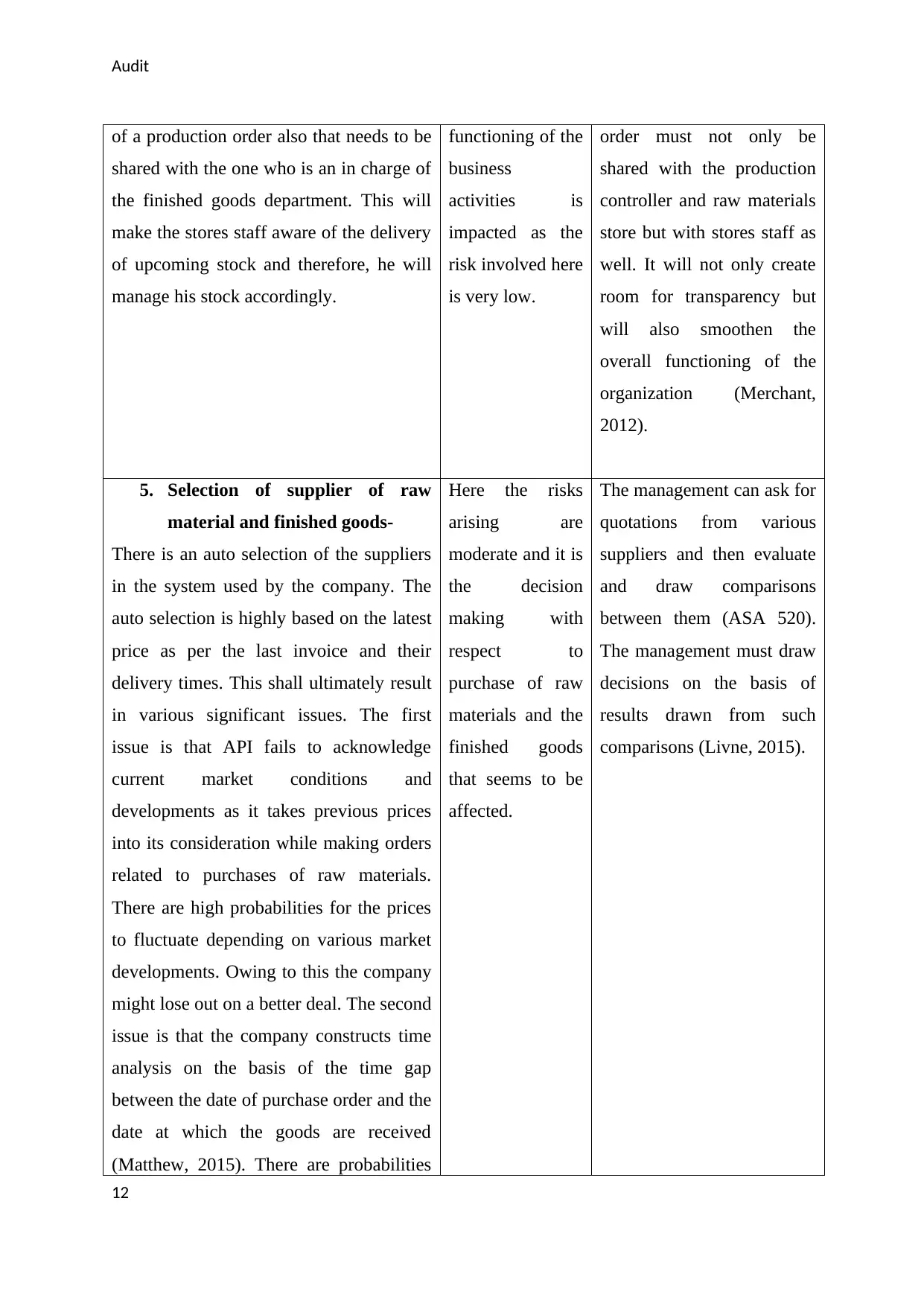
Audit
of a production order also that needs to be
shared with the one who is an in charge of
the finished goods department. This will
make the stores staff aware of the delivery
of upcoming stock and therefore, he will
manage his stock accordingly.
functioning of the
business
activities is
impacted as the
risk involved here
is very low.
order must not only be
shared with the production
controller and raw materials
store but with stores staff as
well. It will not only create
room for transparency but
will also smoothen the
overall functioning of the
organization (Merchant,
2012).
5. Selection of supplier of raw
material and finished goods-
There is an auto selection of the suppliers
in the system used by the company. The
auto selection is highly based on the latest
price as per the last invoice and their
delivery times. This shall ultimately result
in various significant issues. The first
issue is that API fails to acknowledge
current market conditions and
developments as it takes previous prices
into its consideration while making orders
related to purchases of raw materials.
There are high probabilities for the prices
to fluctuate depending on various market
developments. Owing to this the company
might lose out on a better deal. The second
issue is that the company constructs time
analysis on the basis of the time gap
between the date of purchase order and the
date at which the goods are received
(Matthew, 2015). There are probabilities
Here the risks
arising are
moderate and it is
the decision
making with
respect to
purchase of raw
materials and the
finished goods
that seems to be
affected.
The management can ask for
quotations from various
suppliers and then evaluate
and draw comparisons
between them (ASA 520).
The management must draw
decisions on the basis of
results drawn from such
comparisons (Livne, 2015).
12
of a production order also that needs to be
shared with the one who is an in charge of
the finished goods department. This will
make the stores staff aware of the delivery
of upcoming stock and therefore, he will
manage his stock accordingly.
functioning of the
business
activities is
impacted as the
risk involved here
is very low.
order must not only be
shared with the production
controller and raw materials
store but with stores staff as
well. It will not only create
room for transparency but
will also smoothen the
overall functioning of the
organization (Merchant,
2012).
5. Selection of supplier of raw
material and finished goods-
There is an auto selection of the suppliers
in the system used by the company. The
auto selection is highly based on the latest
price as per the last invoice and their
delivery times. This shall ultimately result
in various significant issues. The first
issue is that API fails to acknowledge
current market conditions and
developments as it takes previous prices
into its consideration while making orders
related to purchases of raw materials.
There are high probabilities for the prices
to fluctuate depending on various market
developments. Owing to this the company
might lose out on a better deal. The second
issue is that the company constructs time
analysis on the basis of the time gap
between the date of purchase order and the
date at which the goods are received
(Matthew, 2015). There are probabilities
Here the risks
arising are
moderate and it is
the decision
making with
respect to
purchase of raw
materials and the
finished goods
that seems to be
affected.
The management can ask for
quotations from various
suppliers and then evaluate
and draw comparisons
between them (ASA 520).
The management must draw
decisions on the basis of
results drawn from such
comparisons (Livne, 2015).
12
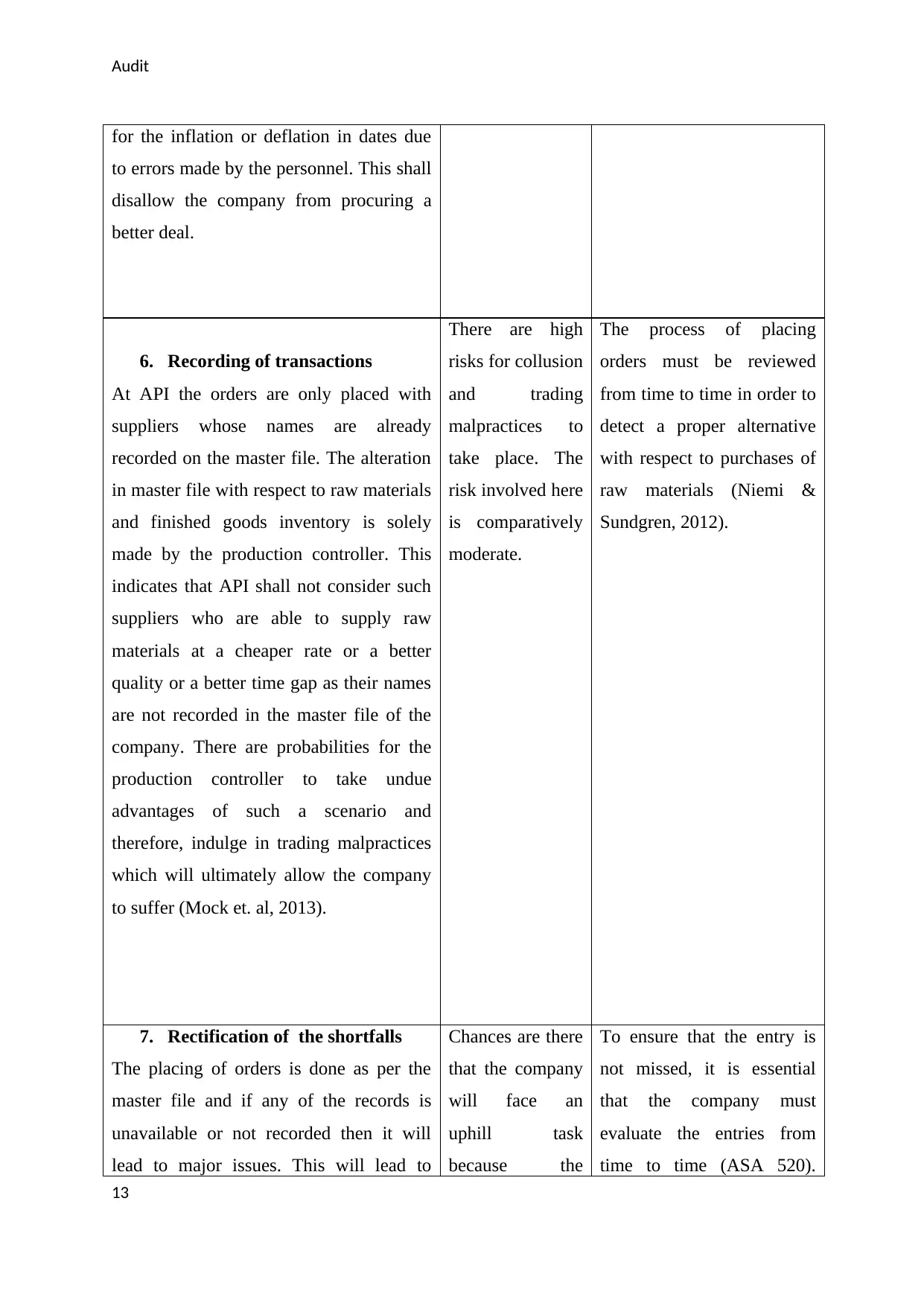
Audit
for the inflation or deflation in dates due
to errors made by the personnel. This shall
disallow the company from procuring a
better deal.
6. Recording of transactions
At API the orders are only placed with
suppliers whose names are already
recorded on the master file. The alteration
in master file with respect to raw materials
and finished goods inventory is solely
made by the production controller. This
indicates that API shall not consider such
suppliers who are able to supply raw
materials at a cheaper rate or a better
quality or a better time gap as their names
are not recorded in the master file of the
company. There are probabilities for the
production controller to take undue
advantages of such a scenario and
therefore, indulge in trading malpractices
which will ultimately allow the company
to suffer (Mock et. al, 2013).
There are high
risks for collusion
and trading
malpractices to
take place. The
risk involved here
is comparatively
moderate.
The process of placing
orders must be reviewed
from time to time in order to
detect a proper alternative
with respect to purchases of
raw materials (Niemi &
Sundgren, 2012).
7. Rectification of the shortfalls
The placing of orders is done as per the
master file and if any of the records is
unavailable or not recorded then it will
lead to major issues. This will lead to
Chances are there
that the company
will face an
uphill task
because the
To ensure that the entry is
not missed, it is essential
that the company must
evaluate the entries from
time to time (ASA 520).
13
for the inflation or deflation in dates due
to errors made by the personnel. This shall
disallow the company from procuring a
better deal.
6. Recording of transactions
At API the orders are only placed with
suppliers whose names are already
recorded on the master file. The alteration
in master file with respect to raw materials
and finished goods inventory is solely
made by the production controller. This
indicates that API shall not consider such
suppliers who are able to supply raw
materials at a cheaper rate or a better
quality or a better time gap as their names
are not recorded in the master file of the
company. There are probabilities for the
production controller to take undue
advantages of such a scenario and
therefore, indulge in trading malpractices
which will ultimately allow the company
to suffer (Mock et. al, 2013).
There are high
risks for collusion
and trading
malpractices to
take place. The
risk involved here
is comparatively
moderate.
The process of placing
orders must be reviewed
from time to time in order to
detect a proper alternative
with respect to purchases of
raw materials (Niemi &
Sundgren, 2012).
7. Rectification of the shortfalls
The placing of orders is done as per the
master file and if any of the records is
unavailable or not recorded then it will
lead to major issues. This will lead to
Chances are there
that the company
will face an
uphill task
because the
To ensure that the entry is
not missed, it is essential
that the company must
evaluate the entries from
time to time (ASA 520).
13
Paraphrase This Document
Need a fresh take? Get an instant paraphrase of this document with our AI Paraphraser
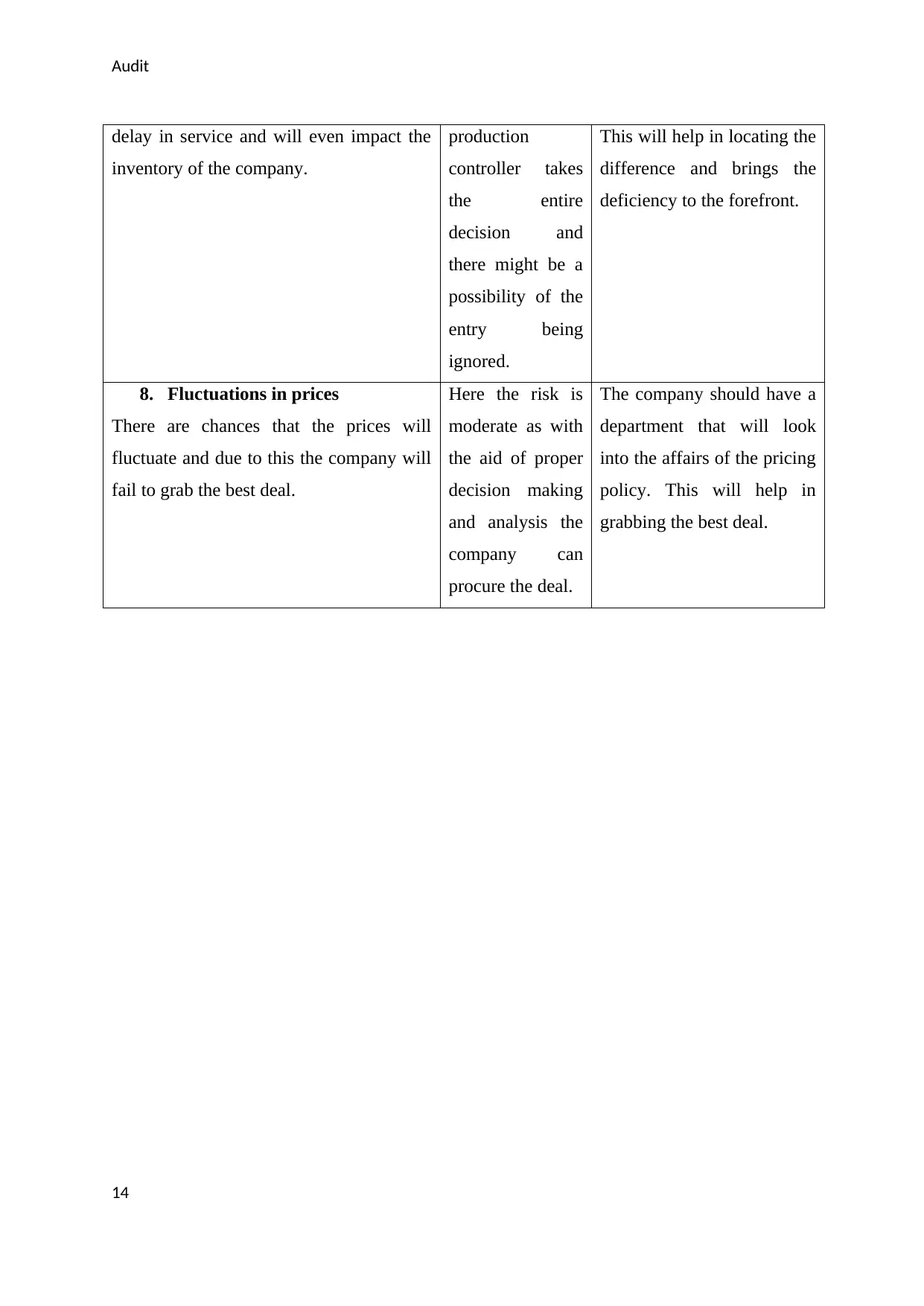
Audit
delay in service and will even impact the
inventory of the company.
production
controller takes
the entire
decision and
there might be a
possibility of the
entry being
ignored.
This will help in locating the
difference and brings the
deficiency to the forefront.
8. Fluctuations in prices
There are chances that the prices will
fluctuate and due to this the company will
fail to grab the best deal.
Here the risk is
moderate as with
the aid of proper
decision making
and analysis the
company can
procure the deal.
The company should have a
department that will look
into the affairs of the pricing
policy. This will help in
grabbing the best deal.
14
delay in service and will even impact the
inventory of the company.
production
controller takes
the entire
decision and
there might be a
possibility of the
entry being
ignored.
This will help in locating the
difference and brings the
deficiency to the forefront.
8. Fluctuations in prices
There are chances that the prices will
fluctuate and due to this the company will
fail to grab the best deal.
Here the risk is
moderate as with
the aid of proper
decision making
and analysis the
company can
procure the deal.
The company should have a
department that will look
into the affairs of the pricing
policy. This will help in
grabbing the best deal.
14
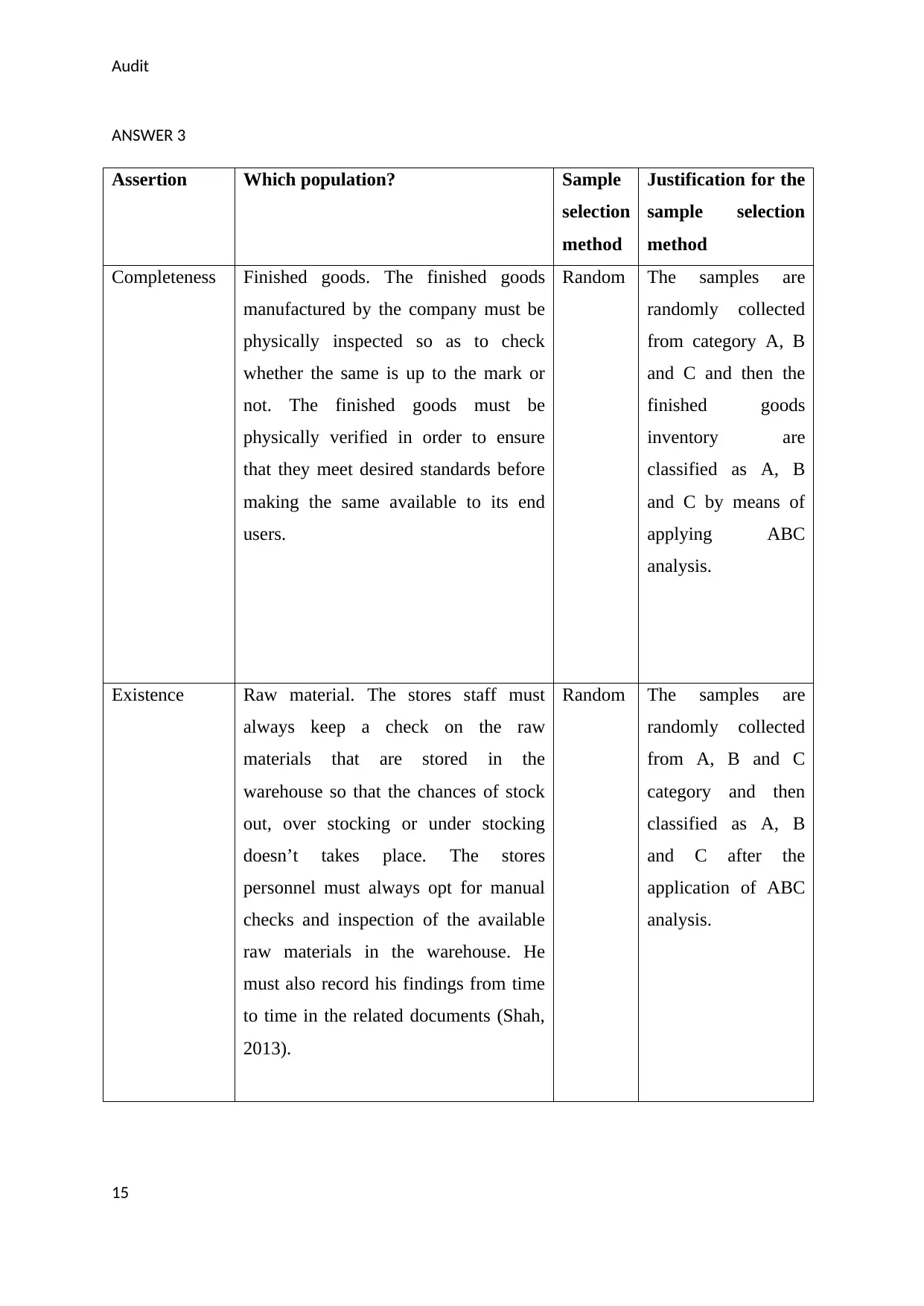
Audit
ANSWER 3
Assertion Which population? Sample
selection
method
Justification for the
sample selection
method
Completeness Finished goods. The finished goods
manufactured by the company must be
physically inspected so as to check
whether the same is up to the mark or
not. The finished goods must be
physically verified in order to ensure
that they meet desired standards before
making the same available to its end
users.
Random The samples are
randomly collected
from category A, B
and C and then the
finished goods
inventory are
classified as A, B
and C by means of
applying ABC
analysis.
Existence Raw material. The stores staff must
always keep a check on the raw
materials that are stored in the
warehouse so that the chances of stock
out, over stocking or under stocking
doesn’t takes place. The stores
personnel must always opt for manual
checks and inspection of the available
raw materials in the warehouse. He
must also record his findings from time
to time in the related documents (Shah,
2013).
Random The samples are
randomly collected
from A, B and C
category and then
classified as A, B
and C after the
application of ABC
analysis.
15
ANSWER 3
Assertion Which population? Sample
selection
method
Justification for the
sample selection
method
Completeness Finished goods. The finished goods
manufactured by the company must be
physically inspected so as to check
whether the same is up to the mark or
not. The finished goods must be
physically verified in order to ensure
that they meet desired standards before
making the same available to its end
users.
Random The samples are
randomly collected
from category A, B
and C and then the
finished goods
inventory are
classified as A, B
and C by means of
applying ABC
analysis.
Existence Raw material. The stores staff must
always keep a check on the raw
materials that are stored in the
warehouse so that the chances of stock
out, over stocking or under stocking
doesn’t takes place. The stores
personnel must always opt for manual
checks and inspection of the available
raw materials in the warehouse. He
must also record his findings from time
to time in the related documents (Shah,
2013).
Random The samples are
randomly collected
from A, B and C
category and then
classified as A, B
and C after the
application of ABC
analysis.
15
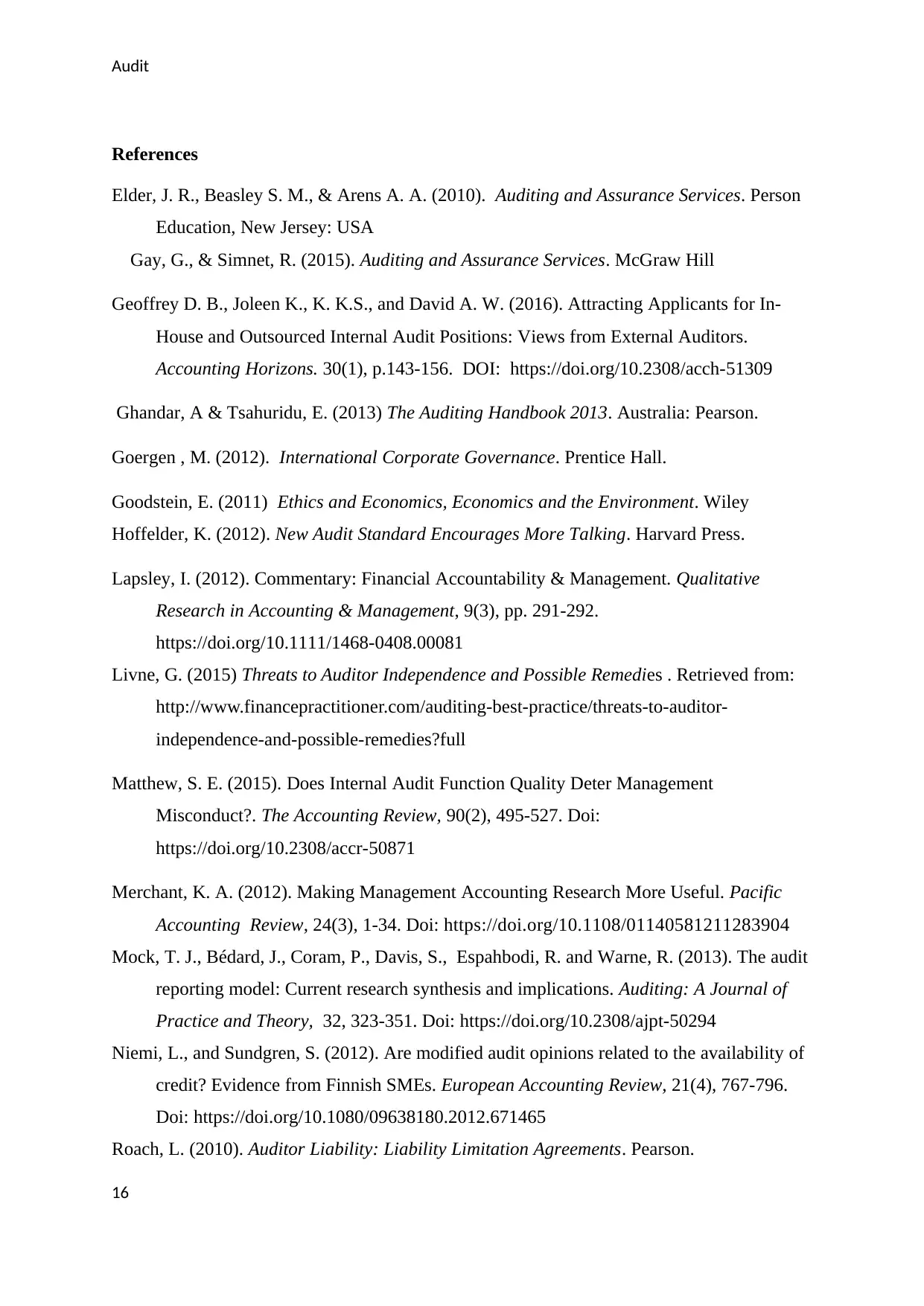
Audit
References
Elder, J. R., Beasley S. M., & Arens A. A. (2010). Auditing and Assurance Services. Person
Education, New Jersey: USA
Gay, G., & Simnet, R. (2015). Auditing and Assurance Services. McGraw Hill
Geoffrey D. B., Joleen K., K. K.S., and David A. W. (2016). Attracting Applicants for In-
House and Outsourced Internal Audit Positions: Views from External Auditors.
Accounting Horizons. 30(1), p.143-156. DOI: https://doi.org/10.2308/acch-51309
Ghandar, A & Tsahuridu, E. (2013) The Auditing Handbook 2013. Australia: Pearson.
Goergen , M. (2012). International Corporate Governance. Prentice Hall.
Goodstein, E. (2011) Ethics and Economics, Economics and the Environment. Wiley
Hoffelder, K. (2012). New Audit Standard Encourages More Talking. Harvard Press.
Lapsley, I. (2012). Commentary: Financial Accountability & Management. Qualitative
Research in Accounting & Management, 9(3), pp. 291-292.
https://doi.org/10.1111/1468-0408.00081
Livne, G. (2015) Threats to Auditor Independence and Possible Remedies . Retrieved from:
http://www.financepractitioner.com/auditing-best-practice/threats-to-auditor-
independence-and-possible-remedies?full
Matthew, S. E. (2015). Does Internal Audit Function Quality Deter Management
Misconduct?. The Accounting Review, 90(2), 495-527. Doi:
https://doi.org/10.2308/accr-50871
Merchant, K. A. (2012). Making Management Accounting Research More Useful. Pacific
Accounting Review, 24(3), 1-34. Doi: https://doi.org/10.1108/01140581211283904
Mock, T. J., Bédard, J., Coram, P., Davis, S., Espahbodi, R. and Warne, R. (2013). The audit
reporting model: Current research synthesis and implications. Auditing: A Journal of
Practice and Theory, 32, 323-351. Doi: https://doi.org/10.2308/ajpt-50294
Niemi, L., and Sundgren, S. (2012). Are modified audit opinions related to the availability of
credit? Evidence from Finnish SMEs. European Accounting Review, 21(4), 767-796.
Doi: https://doi.org/10.1080/09638180.2012.671465
Roach, L. (2010). Auditor Liability: Liability Limitation Agreements. Pearson.
16
References
Elder, J. R., Beasley S. M., & Arens A. A. (2010). Auditing and Assurance Services. Person
Education, New Jersey: USA
Gay, G., & Simnet, R. (2015). Auditing and Assurance Services. McGraw Hill
Geoffrey D. B., Joleen K., K. K.S., and David A. W. (2016). Attracting Applicants for In-
House and Outsourced Internal Audit Positions: Views from External Auditors.
Accounting Horizons. 30(1), p.143-156. DOI: https://doi.org/10.2308/acch-51309
Ghandar, A & Tsahuridu, E. (2013) The Auditing Handbook 2013. Australia: Pearson.
Goergen , M. (2012). International Corporate Governance. Prentice Hall.
Goodstein, E. (2011) Ethics and Economics, Economics and the Environment. Wiley
Hoffelder, K. (2012). New Audit Standard Encourages More Talking. Harvard Press.
Lapsley, I. (2012). Commentary: Financial Accountability & Management. Qualitative
Research in Accounting & Management, 9(3), pp. 291-292.
https://doi.org/10.1111/1468-0408.00081
Livne, G. (2015) Threats to Auditor Independence and Possible Remedies . Retrieved from:
http://www.financepractitioner.com/auditing-best-practice/threats-to-auditor-
independence-and-possible-remedies?full
Matthew, S. E. (2015). Does Internal Audit Function Quality Deter Management
Misconduct?. The Accounting Review, 90(2), 495-527. Doi:
https://doi.org/10.2308/accr-50871
Merchant, K. A. (2012). Making Management Accounting Research More Useful. Pacific
Accounting Review, 24(3), 1-34. Doi: https://doi.org/10.1108/01140581211283904
Mock, T. J., Bédard, J., Coram, P., Davis, S., Espahbodi, R. and Warne, R. (2013). The audit
reporting model: Current research synthesis and implications. Auditing: A Journal of
Practice and Theory, 32, 323-351. Doi: https://doi.org/10.2308/ajpt-50294
Niemi, L., and Sundgren, S. (2012). Are modified audit opinions related to the availability of
credit? Evidence from Finnish SMEs. European Accounting Review, 21(4), 767-796.
Doi: https://doi.org/10.1080/09638180.2012.671465
Roach, L. (2010). Auditor Liability: Liability Limitation Agreements. Pearson.
16
1 out of 16
Related Documents
Your All-in-One AI-Powered Toolkit for Academic Success.
+13062052269
info@desklib.com
Available 24*7 on WhatsApp / Email
![[object Object]](/_next/static/media/star-bottom.7253800d.svg)
Unlock your academic potential
© 2024 | Zucol Services PVT LTD | All rights reserved.





